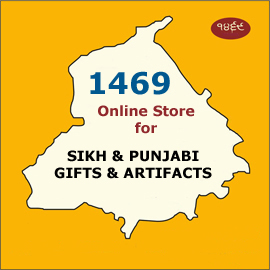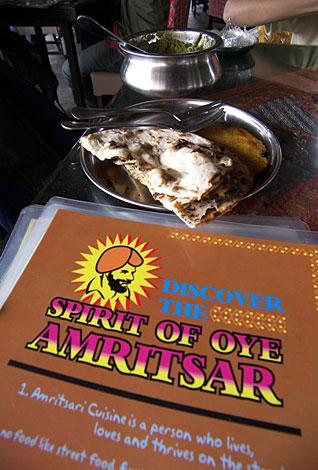Fashion
Modern India's Culture Now Punjabi
by VIR SANGHVI
The last time I went to Colombo (Sri Lanka) a few years ago, I looked at the streets and the people and said to myself, I could be in India. Though a large part of the population of northern Sri Lanka is of Tamil origin, it was Kerala that much of the south reminded me of.
But I still had a nagging feeling that something was different: that somehow I was not in India.
It took me a while to figure it out. But then it hit me with a compelling suddenness: not one woman was wearing a salwar kameez (the Punjabi two-piece shirt-and-trouser version commonly worn by Sikh women).
I contrasted that with the sights I had encountered on the streets of southern India. No matter where I went, whether it was Bangalore, Cochin, Chennai, Hyderabad or the small towns of Kerala, I always found a fair number of women wearing salwar kameezes.
Therefore, it wasn't till I got to Sri Lanka that I asked myself the obvious question: why are so many south Indians wearing a Punjabi dress?
Of course, everyone will have his or her own explanation. Here is mine:
I believe that the change in dress habits is part of the growing Punjabization of India.
And I attribute it to Hindi cinema.
Think about it. Doesn't it surprise you that no matter where you go in India, people want to dance the Bhangra (the popular Sikh and Punjabi dance) in wedding baraats (processions)?
That the rich plan their children's weddings so that they resemble all star-productions - again, Punjabi-influenced - created by Karan Johar with choreography by Farah Khan?
There's more. Think of Hindi film music itself, which has moved so far from its early Bollywood roots that it now seems like the child of a coupling between Western pop and Bhangra music.
And, think of all the phrases that have passed into the nation's language.
Would anyone have used an expression like Chakk de India even a decade ago?
Yet today it has got to the stage where this Punjabi phrase was the Congress party slogan during the Assembly elections in Gujarat. (The province's Chief Minister, Narendra Modi, once asked me which language this was. Was it Italian?)
Now, it's even spread to food. A few months ago, I went to shoot at a small hotel in the Wayanad region of Kerala. I had been looking forward to some good Kerala food. Instead, the buffet was full of black dal, butter chicken, paneer and seekh kebabs - all Punjabi fare. I questioned the manager. He was helpless, he said. This was what his largely south Indian guests wanted to eat when they were on vacation.
I doubt if we can blame butter chicken on the music and dance choreographers, but it's hard to deny that much of the Punjabization is a direct consequence of the films that are being made today.
The Hindi film industry has always been run by Punjabis, but they have usually taken care to set their films in the Hindi heartland or, at the very least, to place their characters in some pan-Indian never-never land.
No more.
These days, the characters all have Punjabi surnames, a far cry from the days when Hindi film characters had no surnames and were known only by a first name, say, Miss Renu or Dr Ashok.
Many of these characters now speak the odd word of Punjabi in their homes and their Punjabi identities are proudly displayed through such titles as Singh is Kinng. Even non-Punjabi actors such as Shah Rukh Khan find their greatest success playing characters who are identifiably Punjabi.
It is possible to overstate the case, but my sense is that the influence of Hindi cinema is so massive that a new popular culture that is Punjabi-dominated has swept all of India. In the South, its influence may be less pervasive than it is in the North, but it is impossible to deny that the Punjabization of south India is also well underway.
I make no moral judgements about this. I am not prepared to say that the Punjabization of the national culture, from one end of the country to the other, is necessarily a bad thing.
But it's worth thinking about, isn't it?
Almost without our noticing, a single state - Punjab - has gripped hold of the public imagination and changed the way in which we live.
[Courtesy: Express Buzz]
April 28, 2009
Conversation about this article
1: Balkar Singh (New Delhi, India), April 28, 2009, 10:45 AM.
There are two cultures in India: the dominant - Punjabi - one, and the desi culture that envelopes all non-Sikhs, that is, the rest of India. Ever since Partition, when Sikhs from Lahore and East Punjab were forced to migrate, India has slowly but surely been shedding its desi-ness and taking on Punjabi traits, but calling them its own. Thus, 'Indian' food around the world is really Punjabi food. India today is clearly identified around the world by the turban, not the topi. Popular 'Indian' music around the world constitutes little more than adaptations of the Bhangra. We haven't even begun to fathom the Sikh components of the sub-continent's classical music, for example, and the Punjabi role in all of its ancient literature. Sports, fashion, films ... you name it, and you'll find there that the better side of it has been shaped by Punjabi taste, the worse of it remains desi!
2: Amrit Kaur (Kanpur, India), April 28, 2009, 10:48 AM.
If you put aside the Punjabi part of modern Indian culture, what's left? Everything else is a confused, impregnable mess and mass of religious gobledegook! Think about it! It's been given an air and veneer of legitimacy by labelling it "classical" or "ancient", etc. The true culture of any society is what its members gravitate to and adapt as their own, voluntarily, even subconsciously, without coercion or artifice.
3: Bikramjit Singh (Marseilles, France), April 28, 2009, 11:00 AM.
I agree with Balkar Singh. Just think how steadily the four icons of desi-ness have gradually disappeared from India's 'high' culture since the Partition and the massive infusion of Punjabiyat by Sikh refugees who then spread across the land: the choti, the dhoti, the sari and the chappal.
4: Kirtan Kaur (Fremont, California, U.S.A.), April 28, 2009, 12:05 PM.
I agree with all of the above. But what about the silliness portrayed about Sikhs in Bollywood's movies? Food, music, dance ... everything has its own place in one's culture. But I see a dark future if our own youth continue to act in the irresponsible ways they they are adrift in nowadays. Wake up, brothers and sisters, before it's too late.
5: Monica Kaur (Houston, Texas, U.S.A.), April 28, 2009, 5:00 PM.
Yes, it is nice that the Punjabi culture has taken a mainstream role in India, but what good is it that everyone recognizes what is Punjabi yet they still fail to realize what is a Sikh. It is great that they prefer Punjabi food, clothing and music, but do they respect the Sikh religion? Perhaps I am getting off topic here as obviously there is a big difference between culture and religion. But what I am really trying to ask is: why get so happy about the culture becoming mainstream when our religion is still oppressed?
6: Bakshish Singh (Oregon, U.S.A.), April 28, 2009, 5:26 PM.
I note that some people are struggling with what to make of this story. Here's what I get out of it: 1) Sikhs, as a people/culture/philosophy that was shaped in the crucible of Punjab, have a lot to be proud of. There is no other community that can surpass it in its values and achievements, no matter which field you look at. 2) It gives us an edge: we can use this to our advantage if we get our act together and educate the world about what we really are. 3) The difficulty that India's non-Sikhs have in accepting Sikhi as their neighbour's faith is THEIR shortcoming, not ours. The fact that Hindu India is narrow-minded and short-sighted cannot be seen as OUR baggage. We are surrounded by a decadent, corrupt, envious and backward society. Therefore, our work is cut out ... all of the above simply means that there is no rest for us.
7: Taj Kaur (Brampton, Ontario, Canada), April 28, 2009, 5:31 PM.
Now, if we can get the clowns in Bollywood to learn how to accurately, fairly and respectfully depict minorities, we have a way of improving that whole country. Teach the people some Sikh values of inter-faith respect, spiritual discipline, work ethic, seva, chardi kalaa ... instead of the garbage they spew right into people's homes and brains. Sadly, both Sikhs and non-Sikhs would benefit from it.
8: Ibadat Gill (U.S.A.), April 28, 2009, 9:46 PM.
I couldn't agree more with Taj Kaur. Well said.
9: Gurjender Singh (Gaithersburg, U.S.A.), April 29, 2009, 8:11 AM.
We always talk about Punjabi and Sikh culture and Sikh values in India and around the world. Please note that after 500 years, the Sikh religion still not recognized by the Indian constitution. The Indian constitution recognizes only Hindus, Muslims and Christians. Sikhs are, tragically, still considered part of the Hindu community. Today, even our own 'leaders' do not pursue this subject!
10: Kanwarjeet Singh (U.S.A.), July 03, 2009, 12:27 AM.
Strange article by an even stranger person - Vir Sanghvi. What you really got to ask my friend is: Is it Punjabiyat influencing Bollywood or the other way around? My friend, it is not Bollywood helping to spread Punjabiyat - it is the open hearted warm nature of Punjabiyat that helps Hindi movies sell.
11: Surjit Kaur (Yuba City, California, U.S.A.), January 12, 2010, 10:36 PM.
Very nice.
12: Jas (Paitiala, Punjab), June 04, 2013, 11:18 AM.
Good article.






